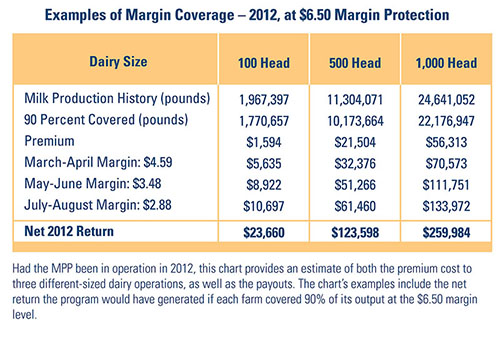Revised Dairy Safety Net Presents a New World for Farmers
April 4, 2014
 It may not match Columbus’s discovery of America, but when a revised federal safety net kicks in after September 1, it will definitely be a New World for dairy farmers. And the same question is on virtually every farmer’s mind: what will this mean for me?
It may not match Columbus’s discovery of America, but when a revised federal safety net kicks in after September 1, it will definitely be a New World for dairy farmers. And the same question is on virtually every farmer’s mind: what will this mean for me?
Many of the details remain to be worked out. But here’s what we know now, starting with the basics.
The new program, called the Dairy Producer Margin Protection Program, is a voluntary risk management program that will help prevent the kind of catastrophic equity losses that hit dairy farmers in the 2008-2009 recession and again in 2012. It will address fluctuations in margins caused by both low milk prices and high feed costs.
The Margin Protection Program replaces price supports, MILC payments and other, less effective federal programs for dairy. It was enacted as part of the 2014 farm bill and was the product of five years of work by the National Milk Producers Federation and numerous dairy cooperatives and organizations across the country.
How MPP Will Work
All dairy farms will be eligible to participate. Two or more producers involved with a single operation will be treated as a single farm. Multiple farms operated by a single producer will register separately. Sign-ups will be at the local USDA Farm Service Agency (FSA) office.
Producers will be able to insure their margins on a sliding scale, both for how much milk production is covered and for the specific margin level selected. Basic coverage, starting at $4 per hundredweight, will be paid by the government. Above $4, premiums will be shared between the farmer and the Agriculture Department. The program will pay out benefits to all producers equally, regardless of size.
The program will pay producers when national average margins for periods of two consecutive months (Jan.-Feb., Mar.-April, and so on) fall below the coverage level chosen by the producer. During such periods, it will pay on one-sixth of a farm’s annual production history, multiplied by the percentage of production selected by the producer.

Margins are defined as the all-milk price minus national average feed costs. Feed costs will reflect the cost of feeding all animals on a farm, including heifers and dry cows. Initially, a farm’s production history will be the highest annual production among the last three years. After the first year, a farm’s production history will increase, based on the average growth in milk production nationally. Any milk production growth on a farm beyond the national average will not be covered.
Producers will choose to insure from 25 percent to 90 percent of production history, in five percent increments. Margin coverage will be in 50-cent increments, from $4 per cwt. to $8 per cwt. Premiums will be fixed for five years but will be discounted by 25 percent in 2014 and 2015 for volumes up to 4 million pounds. There will also be an annual administrative fee of $100 to enroll.
Donation Program
The farm bill also created a Dairy Product Donation Program that will be triggered when margins are extremely low. If margins fall below $4 per cwt. for any two consecutive months, the Agriculture Department will purchase consumer-ready dairy products for donation to food banks and other low-income feeding programs. Purchases will continue for three months, or until margins rebound above $4.
USDA cannot store the dairy products and organizations receiving products cannot sell them in commercial markets.
What Happens Next?
USDA’s Farm Service Agency is just beginning the process of setting up the Margin Protection Program. This will take much of 2014. The National Milk Producers Federation is working with FSA to ensure the program is effective and farmer-friendly. But at this point there are lots of unknowns, including:
- When will coverage start and when will sign-up begin?
- Can farmers insure different portions of their production at different levels?
- How will new entrants be handled, as well as those selling or leasing operations?
NMPF will be working with the Agriculture Department to answer these and other questions as the rules for the new program are written. NMPF’s Future for Dairy website is being refashioned into a hub for information on the program and its implementation. Check www.futurefordairy.com for updates.






